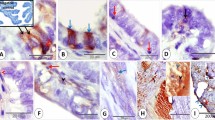Summary
Estrogen receptors in frozen section of the rat uterus were demonstrated by a radiolabeled ligand binding technique. The bound hormone was extracted with ethanol and measured by liquid scintillation. The binding of 3H-estradiol-17β at various molar concentrations was inhibited by a 100-fold excess of DES, and the bound 3H-estradiol resisted exhaustive washings at 4°C for 16 h. These binding sites were not present in the sections of the spleen, and perhaps at a very low concentration in the myocardium. Thus their binding behavior and distribution pattern are consistent with those of specific estrogen receptors. The hydrophilic fluorescent estradiol conjugate, 17β-estradiol-6-CMO-BSA-FITC was found to be a highly effective competitor against binding of 3H-estradiol to its receptors in tissue sections, and is considered a useful histochemical reagent for localizing target cells with high concentrations of estrogen receptors. Estrogen receptor sites in frozen sections of human breast cancer were also measured by this radiolabeled ligand binding technique, and expressed in femtomoles of hormone bound per 1,000 cancer cells. The values were parallel to the histochemical findings in terms of percentage of the estrogen receptor-positive in the cancer cell population.
Similar content being viewed by others
References
Brökelmann J (1969) Peroxidase—associated binding of estradiol by the rat uterus. J Histochem Cytochem 17:394–407
Chamness GC, Mercer WD, McGuire WL (1980) Are histochemical methods for estrogen receptor valid? J Histochem Cytochem 28:792–798
Clark JH, Hardin JW, Upchurch S, Eriksson H (1978) Heterogeneity of estrogen binding sites in the cytosol of the rat uterus. J Biol Chem 253:7630–7634
Dandliker WB, Brawn RJ, Hsu M-L, Brawn PN, Levin J, Meyers CY, Kolb VM (1978) Investigation of hormone-receptor interactions by means of fluorescence labeling. Cancer Res 38: 4212–4224
DeSombre ER, Puca GA, Jensen EV (1969) Purification of an estrophilic protein from calf uterus. Proc Natl Acad Sci USA 64:148–154
Eriksson HA, Hardin JW, Markaverich B, Upchurch S, Clark JH (1980) Estrogen binding in the rat uterus: heterogeneity of sites and relation to uterotrophic response. J Steroid Biochem 12:121–130
Jensen EV, Jacobson HI (1962) Basic guides to the mechanism of estrogen action. Recent Prog Horm Res 18:387–414
Jensen EV, DeSombre ER (1972) Mechanism of action of the female sex hormones. Annu Rev Biochem 41:203–230
Johansson H, Terenius L, Thorén L (1970) The binding of estradiol-17β to human breast cancers and other tissues in vitro. Cancer Res 30:692–698
King RJB, Barnes DM, Hawkins RA, Leake RE, Maynard PV, Millis RM, Roberts MM (1979) Measurement of oestrogen receptors by five institutions on common tissue samples. In: Steroid receptor assays in human breast tumours: methodological and clinical aspects. Alpha Omega Publishing Ltd, Cardiff, pp 7–15
Kurzon RM, Sternberger LA (1978) Estrogen receptor immunocytochemistry. J Histochem Cytochem 26:803–808
Lee SH (1978) Cytochemical study of estrogen receptor in human mammary cancer. Am J Clin Pathol 70:197–203
Lee SH (1979) Cancer cell estrogen receptor of human mammary carcinoma. Cancer 44:1–12
Lee SH (1980a) Cellular estrogen and progesterone receptors in mammary carcinoma. Am J Clin Pathol 73:323–329
Lee SH (1980b) Estrogen and progesterone receptors in breast cancer: A new approach to measure. Conn Med 44:622–625
Lee SH, Torack RM (1968) The effects of lead and fixatives on activity of glutamic oxalacetic transaminase. J Histochem Cytochem 16:181–184
Nenci I, Dandliker WB, Meyers CY, Marchetti E, Matzola A, Fabris G (1980) Estrogen receptor cytochemistry by fluorescent estrogen. J Histochem Cytochem 28:1081–1088
Pertschuk LP, Gaetjens E, Carter AC, Brigatti DJ, Kim DS, Fealey TE (1979) An improved histochemical method for detection of estrogen receptors in breast cancer: Comparison with biochemical assay. Am J Clin Pathol 71:504–508
Skinner LG, Barnes DM, Ribeiro GG (1980) The clinical value of multiple steroid receptor assays in breast cancer management. Cancer 46:2939–2945
Tchernitchin A (1967) Autoradiographic study of (6,7-3H) oestradiol-17β incorporation into rat uterus. Steroids 10:661–668
Terenius L (1968) Selective retention of estrogen isomers in estrogen-dependent breast tumors of rats demonstrated by in vitro methods. Cancer Res 28:328–337
Toft D, Gorski J (1966) A receptor molecule for estrogens: Isolation from the rat uterus and preliminary characterization. Proc Natl Acad Sci USA 55:1574–1581
Walker RA, Cove DH, Howell A (1980) Histological detection of oestrogen receptor in human breast carcinomas. Lancet 1:171–173
Author information
Authors and Affiliations
Rights and permissions
About this article
Cite this article
Lee, S.H. The histochemistry of estrogen receptors. Histochemistry 71, 491–500 (1981). https://doi.org/10.1007/BF00508375
Received:
Accepted:
Issue Date:
DOI: https://doi.org/10.1007/BF00508375




